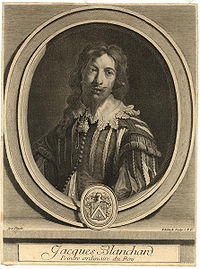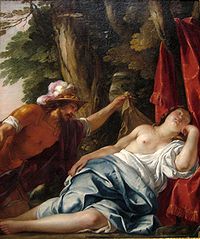
Jacques Blanchard
Encyclopedia


Baroque
The Baroque is a period and the style that used exaggerated motion and clear, easily interpreted detail to produce drama, tension, exuberance, and grandeur in sculpture, painting, literature, dance, and music...
painter who was born in Paris. He was raised and taught by his uncle, the painter Nicolas Bollery (ca. 1560–1630). Jacques’s brother and son, Jean-Baptiste Blanchard (after 1602–1665) and Gabriel Blanchard
Gabriel Blanchard
Gabriel Blanchard, known as Blanchard Le Neveu, the only son of Jacques Blanchard, was born in Paris in 1630, and studied under his uncle, Jean Baptiste Blanchard. He was, in 1668, elected Academician on the merits of an allegorical painting of the 'Birth of Louis XIV,' now at Versailles; but his...
(1630–1704), respectively were also painters.
Jacques spent the years from 1624 to 1628 studying in Bologna
Bologna
Bologna is the capital city of Emilia-Romagna, in the Po Valley of Northern Italy. The city lies between the Po River and the Apennine Mountains, more specifically, between the Reno River and the Savena River. Bologna is a lively and cosmopolitan Italian college city, with spectacular history,...
and Venice
Venice
Venice is a city in northern Italy which is renowned for the beauty of its setting, its architecture and its artworks. It is the capital of the Veneto region...
. After briefly working in Turin
Turin
Turin is a city and major business and cultural centre in northern Italy, capital of the Piedmont region, located mainly on the left bank of the Po River and surrounded by the Alpine arch. The population of the city proper is 909,193 while the population of the urban area is estimated by Eurostat...
at the court of the Charles Emmanuel I, Duke of Savoy
Charles Emmanuel I, Duke of Savoy
Charles Emmanuel I , known as the Great, was the Duke of Savoy from 1580 to 1630...
(ca. 1628) he returned to France and set himself up in Paris in 1629. Jacques Blanchard is best known for his small religious and mythological paintings. He died in Paris in 1638. This painter should not be confused with the French sculptor of the same name who lived from 1634 to 1689.
Nothing seems to be known of his work before he left for Rome at the age of twenty-four. After two years he moved to Venice, where he remained for two more years. It was there that his style was formed. He then went to Turin, where he worked for the Dukes of Savoy, before returning to France 1628. It is from the brief but productive period after his return that all his dated works survive. They show him to stand quite apart from his contemporaries, not only in his painting style but also in his choice of sensual subject-matter, for example the Bacchanal at Nancy.
The chief influences were the sixteenth century painters, especially Titian
Titian
Tiziano Vecelli or Tiziano Vecellio Tiziano Vecelli or Tiziano Vecellio Tiziano Vecelli or Tiziano Vecellio (c. 1488/1490 – 27 August 1576 better known as Titian was an Italian painter, the most important member of the 16th-century Venetian school. He was born in Pieve di Cadore, near...
and Tintoretto
Tintoretto
Tintoretto , real name Jacopo Comin, was a Venetian painter and a notable exponent of the Renaissance school. For his phenomenal energy in painting he was termed Il Furioso...
with their rich, warm colours, and Veronese
Paolo Veronese
Paolo Veronese was an Italian painter of the Renaissance in Venice, famous for paintings such as The Wedding at Cana and The Feast in the House of Levi...
, whose blond and silvery colour and limpid light he used most effectively in his small religious and mythological subjects. The several versions of Charity, depicted as a young woman with two or three children, are excellent examples of his tenderness of colour handling, and of a softness of sentiment nearer to the 18th than to the 17th century. He was also a sensitive portrait painter, and played a leading part in French painting of the 1630s.

